Blue Ox Base Plate Kit - Removable Arms

Will this fit?
To see if this custom-fit item will work for you please tell us what vehicle you'll use it with.
Thank you! Your comment has been submitted successfully. You should be able to view your question/comment here within a few days.
Error submitting comment. Please try again momentarily.
- All Info
- Reviews (3043)
- Q & A (0)
- Videos (1)
- Photos
Blue Ox Base Plates - BX3616
- Removable Drawbars
- Blue Ox
- Twist Lock Attachment
Custom designed to fit your vehicle so it can be safely towed behind your RV, this base plate has easily removable arms that offer a seamless look when you're not flat towing. Base plate bolts directly to your chassis, so no welding is required.
Features:
- Custom-fit base plate provides attachment points for your tow bar when flat towing
- Hidden design provides a clean, seamless look
- Arms remove with a simple twist when not in use
- Brackets won't protrude past the front of your vehicle
- Sturdy design spreads towing force evenly to prevent stress on your vehicle's suspension
- Integrated mounting points let you easily attach an electrical connector plug with bracket (sold separately)
- Receiver covers keep dirt and debris out of the base plate when arms are removed and provide a finished look
- Durable steel construction is powder coated to resist rust and corrosion
- Straightforward installation - no welding required
- Base plate bolts securely to your vehicle's chassis with included mounting hardware
- Sturdy lugs pair with Blue Ox tow bars to form a secure and reliable connection
- Adaptable for use with Roadmaster tow bars - adapter (RM-031 or RM-031-5) sold separately
- Adaptable for use with Demco tow bars - adapter (BX88310) sold separately
- Made in the USA
Specs:
- Distance between brackets: 18"
- Bracket height: 17-1/2"
- 3-Year warranty
Simple, Hidden Design


This base plate's hidden design creates a clean and seamless look. The bracket arms are easily removable, creating a slick appearance when you're not flat towing. Because the arms can be removed, you also won't have to worry about banging your leg into any protruding arms when you walk by.

Attaching and removing the bracket arms is a breeze. To attach the arms to the base plate, simply insert them into the receivers and rotate them until they lock into place. Once you're finished towing and want to remove the arms, pull the pin to disengage the lock, rotate the arms, and remove them from the receivers. Finally, plug up the now empty receivers with the included receiver covers to help keep dirt and debris out of the base plate and provide a finished look.
Guide to Flat Towing
Flat towing your vehicle is much more convenient than using a trailer or a tow dolly. These other options take up much more storage space, leaving you less room both at home and at the campsite. In addition, securing your vehicle to a trailer or tow dolly can be a hassle and more time consuming than hooking up with a tow bar.
There are 5 basic components needed when flat towing a vehicle: a tow bar, a base plate kit, a safety cable set, tow bar wiring, and a supplemental braking system.

The tow bar links your towed car to your motorhome. It attaches to the custom-fit base plates that install on the frame of your towed car. Safety cables ensure that your towed car does not separate from your motorhome in the event that your tow bar becomes detached. Tow bar wiring allows your towed vehicle's signal lights to sync up with your motorhome's tail lights, which is required by law in most states. Finally, the supplemental braking system - also required in most states - brakes your towed car when the brakes in your motorhome are activated, preventing wear on the motorhome and decreasing braking distance for your entire setup.
BX3616 Blue Ox Baseplate - Removable Tabs
Installation DetailsThis Product Fits The Following Vehicles
- 2009 - 2013 Subaru Forester 2.5X and 2.5X Premium - Manual transmission
- 2009 - 2013 Subaru Forester excluding 2.5X and 2.5X Premium - Manual transmission


Videos are provided as a guide only. Refer to manufacturer installation instructions and specs for complete information.
Video Transcript for Blue Ox Base Plate Kit Installation - 2009 Subaru Forester
Today on our 2009 Subaru Forester, we're going to be taking a look at and showing you how to install the Blue Ox base plate kit with removable arms, part number BX3616. So here's what the base plate is going to look like once we have it installed on our Forester. This is going to serve as the attachment point for our tow bar to hook directly up to our Subaru. Now, this is going to distribute that weight across the front of the vehicle a lot better, taking some of that excess weight off of the front suspension. Now, whenever we're not towing, we're going to be able to easily remove these arms here. You can simply pull on the pin, rotate it, and we can pull it out and installing them is just as easy.
We'll slide it in until the pin makes contact, push it in, and rotate it until it locks into place.Around the outside of our attachment point we're going to have our safety chain connection points. And as you can see, we're going to have plenty of room to get those hooked up, even with some of those oversized hooks. Blue Ox even provided us a spot that we can mount up our electrical connector, making it a lot easier to route everything. Our Blue Ox base plate is going to work for a wide variety of Blue Ox tow bars, as well as some Roadmaster tow bars with an adapter that is sold separately. Now, really the big benefit to this style of base plate is the fact that our tow bar is going to hook directly to this.
We're not going to have a separate bar or that crossbar that's going to go across, our tow bar is just going to hook directly into the arms. And as you can see, whenever we remove the arms when we're not towing, it's going to blend in really nice with the bottom of the grill here, and we're not going to have to do too much cutting on the grill. At least not anything that you can see.To keep any kind of debris out of our base plate and help protect it, they do provide us with these caps that we can put in. Again, they're black, so it's just going to blend in nicely to the bottom of the car here. To begin installation we're going to want to open up our hood and we're going to have six push pins that are holding the upper part of the grill in place.
There's going to be three on each side. So you want to grab a flat head screwdriver and there's going to be a small notch in the push pin. You come underneath that notch to pop out the center section. We can lift it up, pop out the rest of the clip. We'll repeat that for all the remaining pushpins.In front of the front tire here, inside the wheel wall, right about where our fender meets our fascia, we're going to have a fastener.
Now, typically it is going to be a push pin, but ours has been replaced with a bolt. So if it is a push pin, you're going to want to push that center section in and then you can pull it out.But in our case, we're going to take an eight millimeter socket and pull this bolt out. You'll do that on the other side as well. Now, if we come to the bottom side, right where that front mud flap is, the very corner, we're going to have another push pin that we're going to need to remove. So again, kind of come into that center section. We're going to pop that center section out, so take the tension off of it. Once it's released, getting a little bit of trouble with ours, but if it's released from the bottom that's okay, it's all we really need. As we move forward in front of the mud flap underneath our fog lights and in the front of our Subaru, we'll have another push pin towards the outside edge. And then one right underneath the grill.Now we're going to have the same combination on the other side, so we can remove those too. Now with an extra set of hands we're going to start at the corner where our fender meets our fascia, and we're going to start pulling it away, unlocking those clips. And once we get it loose, we don't want to pull too far away, because we're going to have to disconnect our fog lights down here. So if we're pushing on that tab, should be able to pull down and then pull that connector out. And then we'll pull our fascia away and we're going to set it aside where it won't get damaged. Now on the driver's side, right behind the bumper beam itself, we're going to have this sensor that's fastened in with a bolt. You would want to grab a 10 millimeter socket and we can pull the bolt out.We'll just let our sensor hang down out of the way for now. Now on the passenger side, in the same general location, we're going to have a wiring loom with a clip holding it onto the frame. So going to grab a trim panel tool or a flathead screwdriver, and we're going to pop that push pin out of the frame. We'll just move our wiring back out of the way. Now we're going to have to remove our bumper beam. We're going to have four bolts holding it in place, two on the top and then two on the bottom side. So then I want to grab a 12 millimeter socket and we'll pull those out.Now, when you do remove these, you want to make sure that you at least leave one, just hand tight, maybe a couple of threads so that it doesn't fall off, when you take the last bolt out. So we're going to remove the last bolt, making sure we have a firm grip on the bumper beam, lift up slightly and we can pull it off, and we're going to set it aside for now. Now right in the corner here I already marked out. But while our bumper beam is removed, we're going to have to notch this small section. It's going to be even with this lower part of the flange. So you want to come right below the mounting hole for the bumper beam, go over it until it lines up with the outer edge here and just make that small triangle cut. Now I'm going to be using a rotary tool. You can use a reciprocating saw or a grinder, whatever's going to be easiest for you.We have this side notched out. We're going to go ahead and repeat that for the other side as well. It's never a good idea to leave exposed metal on your vehicle. So I'm going to take a little bit of spray paint. I'm going to spray where I cut, hopefully preventing any kind of rust or corrosion. And we'll do that for both sides that we've cut. Now in the center, right by our radiator, but a little bit towards the driver's side, we're going to have this sensor here and that's going to be our ambient temperature sensor. We're going to have to push it back towards the radiator just a bit so we can make clearance for our base plate. Now the easiest way is just to take a pair of pliers, we're just going to bend it back slightly on each side. You just want to be careful when you are bending it. You don't want to have your pliers go into the radiator or have the sensor go too far back and cause any damage.Now on the side of the frame here we're going to several different holes, the large one in the center is going to be reamed out to a half an inch. So we can grab a half inch drill bit and a drill. We're just going to make sure that it's a full half inch around, and we're going to do that for the other side as well. Please grab one of the shorthand bolts to make sure that the holes is going to be large enough to fit.At this point we can get ready to put our base plate up and hanging in place. Before we do, we're going to take our hardware, I'm going to take two of the half inch bolts, and we're going to take some red Loctite. We're just going to put a little bit on the threads. It's going to make it a lot easier doing it now, rather than trying to hold the base plate and do it, and then put your hardware in place. Just want to make sure you put a small bit of Loctite on each piece of hardware. Now, the next thing is, we're going to take our base plate. And since it's such a tight fit, you're going to have to do this at the same time on each side. So we'll slide it in and then we're going to rotate it up to where it levels out.Then we're going to line up the large hole with the hole that we drilled. We can take that half inch bolt, we're going to go through our base plate and into the frame. We're going to follow the bolt with a flat washer and then a half inch lock washer. And then finally we're going to secure it down with a half inch lock nut. Now we at least want to get this on there a couple threads, just hand tight so we know our base plate won't come falling down. And we'll do the same combination on the other side. So with our base plate loosely in place, you'll notice that we're going to have a few more holes, we'll have two more up top by the half inch bolt. And then one more at the very bottom that we're going to have to drill out.But if we look through this forward hole on top, you'll notice that there's going to be a weld nut on the inside of the frame. So we can either drill that out, which I'll tell you can take a lot of time, or to make it easier on ourselves we can take a chisel and we're going to knock that weld nut out. Now we can come back with a drill bit and we're going to want to drill them out so the 3/8 bolt can fit through each one of those three locations. So we're going to leave the base plate in position and use it as a template and then go through and drill in each mounting location. So we have the top one done. We're going to repeat that for this back side one, as well as the one on the very bottom. So now that we have the holes drilled, we're going to take our short 3/8 bolts, and we're going to double-check that they fit through the holes inside of our base plate.And then again we're going to take a little bit of Loctite, put it on the threads, and we'll pass it through. And we're going to use the short bolts for up top, making sure they go through the base plate and then through the frame. And then just like with the half inch bolt we're going to take a 3/8 flat washer, slide it over the bolt, followed up by a 3/8 lock washer, and then secure it down with a 3/8 locknut. We'll do that for both bolts. Now the driver's side is going to work the same way, except for the hole that's going to be towards the back. That one is also going to hold our sensor in place. So you're going to want to get it lined up, but the hole through the sensor isn't going to be large enough, and that tab here is going to be in the way. So we can either cut that alignment tab off or bend it flat.You can you just take a pair of pliers and bend it so it's going to be out of the way so that our sensor can sit flat against the bracket. But we are going to have to ream out the hole so we can take our drill bit that we used to drill out the base plate. And we're just going to drill this big enough so that 3/8 bolts could go through it.So the hole drilled out, we're going to pass our bolt through, line it up with our base plate, and then we'll secure it down with the same combination of hardware we did with the other ones. Now on the bottom we went ahead and took the long 3/8 bolt, again applying that red Loctite to it and slid it through. However, there is a gap in between our base plate and the frame. So we've put that spacer in between there to take up that gap and then follow it up with the hardware that we've been using, flat washer, lock washer, and then lock nut. And we did that for both sides. Now we're going to come back and we're going to tighten up all of our hardware. Got our 3/8 bolts and nuts we're going to be using a 9/16 wrench and socket. I just want to tighten it up so it's nice and snug. Now for our half inch hardware, we're going to be using a 3/4 inch wrench and socket to snug those up.Now they're all snug. I'm going to come back with a torque wrench and I'm going to torque all my hardware down to the specified amount in the instructions. We're going to make sure to repeat that for all of our remaining hardware. Just double check the chart to make sure that you have the correct spec for each size bolt. So with our base plate all secure we're going to want to put on our permanent safety cables. Now the main thing with these is you want to wrap them around the frame and then we'll take the quick link and attach both ends to the attachment point here on the end of the base plate. Now you're probably going to have some access cable. So what I'm going to do is I'm just going to kind of push it aside, take some zip ties and secure everything down so it won't interfere with the bumper or any other wires or anything back here.So I just took a zip tie and tying my safety cable to the base plate, so it be nice and tight against it, and then took the excess and loosely zip tied it to some of these existing wires back here so that it wouldn't be sticking out. So now that we have the facial off and are baseplate secure, now it'd be a good time to go ahead and run your wiring for your lighting system. So we went ahead and did that so it's easier to route them up to the front here and not have to worry about the fascia. So now we can take our bumper beam. We're going to line it up. And there is these two little keeper tabs on the top. We're going to want to make sure that they go over the frame, kind of sit on there and help support it.You going to want to get at least one bolt on each side, a couple of threads so we don't have to worry about it falling off. Now you'll notice on the bottom hole here it's going to be really close to the base plate. So when we put a bolt through, there is a chance that it is going to make contact. So in the kit, they're going to provide us with two, 5/16s flat washers. I'm just going to put them on that bolt. So that way it takes up a little bit of space, we still have enough threads to engage it and fully secure it. So we're going to want to put two flat washers on each bolt that's going to be close to the base plate. Now we can come back with a 12 millimeter socket and tighten down all the bolts. And you can see with those two washers it gives us just enough space to where that bolt is not going to be actually driving into the base plate.So now with an extra set of hands we're going to lift our fascia up, but don't forget to plug your fog lights in. Make it a lot easier putting the fascia on. We'll get everything loosely lined up. You want to double check down here just to make sure all the tabs are going through the opening. You can start working everything back into place, make sure the plastic goes in the correct spots. You have to lift up a little bit to get those clips to line up. Now once we get our fascia back in place, we noticed that it's not quite fitting how it should. And we noticed that right here on the lower section of the grill, this piece is actually hitting the base plate. So we're going to need to notch out a little bit right here so that it's not pushing against it and causing it not to sit properly. Now to make sure our fascia doesn't fall off we're going to go ahead and put a few fasteners back in on the top.When you put the push fasteners back in, you're going to want to make sure that center section is still sticking out. Push it into the hole, the outer part first, and then lock it down by pushing in the center section. Now we're going to start working on putting all the other fasteners back in place that we took out earlier. These underneath can be a little bit of a struggle, but you're going to want to make sure that outer ring is pushed in first, going through both layers of plastic, and then you lock it down with the center. That'll finish up your look at the Blue Ox base plate kit with removable arms, part number BX3616 on our 2009 Subaru Forester.
Customer Reviews
Blue Ox Base Plate Kit - Removable Arms - BX3616
Average Customer Rating: 4.8 out of 5 stars (3043 Customer Reviews)
Custom designed to fit your vehicle so it can be safely towed behind your RV, this base plate has easily removable arms that offer a seamless look when you're not flat towing. Base plate bolts directly to your chassis, so no welding is required.
The base plate went on our Subaru Forester as described. It looks great and unless you know what to look for you wouldn't expect our car is towed.
Received the product and everything looks good. Thanks for the additional instructions

it has been very good have traveled from nc to fla. to dallas tx back to nc then to philly pa then to nc and ga threw 2021 and more travel in 22 very satisfied.

The size of the box terrified me but I had to do this one myself.
This project is not for the faint of heart. When you think about what could go wrong you could wet yourself. I went with my gut and just opened the box. Hmmm, packaged very well with everything you need for the install. No going to the hardware store for this or that. Sat there with a cold sarsaparilla and read the very detailed instructions, went back to the etrailer web site and checked out some vids and pics. Hmm, it didn’t seem that daunting of a job. On my 04 Lexus GX470 most of the holes were drilled. Before I knew it 5 hours had past and I owned a toad! I took it to my local Rv service center for an inspection and it was deemed safe to use.
This thing is awesome, tracs straight as an arrow.
Now, I have to figure out this diode lighting kit. Camping is fun! Yah!!! :) Noah and etrailer made this a tolerable project. I urge everyone to take advantage of the resources that are on this sight. I always learn something when I’m there. See y’all on the trail….Rod
Well, I'm glad I'm good with tools, grinders, drills, and such. It was not just bolt-on dal. The car grill was able to be used any longer as it was too tight of a fit. Some of the lower fascia had to be trimmed and also removed OEM nuts from the front, the angle wouldn't allow the stock nuts to work. But in the end, I got to work out. So prepare to spend around 4-6 hours playing with it to get it to work. I am positive it's going to work as intended.
everything bolted up easy, i simply drilled hole’s into were needed and supplied my own bolts straight through for easy installation.
I am really happy, not only with the product but the customer care I received. Very quick and helpful!!
I would make one suggestion. Take the headlights out when doing this on a Chevy Cobalt. It will make it much easier to get to the 3 bolt holding the fender to the fascia.

This kit fit well, had decent instructions, and performed perfectly every time once installed. If doing the install yourself, you'll need some metal fabrication tools to notch the D-ring plates behind the bumper but it's not complicated, just a little time consuming depending on the tools you're using. The look is also a little weird on the front of a new Bronco since you're losing the burly bumper D-rings, but it's a well engineered setup overall. I only used the tow bar setup a couple times before the vehicle was lost in a wildfire so I can't comment on the longevity, but I have no doubt it would still be working fine today.

I will start with the people that work here at etrailer are great to deal with and very helpful! These baseplates for my 2023 bronco have been great. i bought and installed myself. install pretty straight forward. and these work great for flat towing my bronco behind my motorhome.

eTrailer was very helpful in choosing the correct hitch for our rv and car. They also provided a special brake application in the car that makes it super easy for toad braking.
I am 72, and I hook up this toad and pull it with confidence. The instructions to hook up the toad was presented with ease. They knew exactly what they were doing, and we didn't rush through the demonstration. I would recommend eTrailer to anyone.
Installed successfully on my 2024 Trax LT. However, with respect to the following installation steps, I made some changes:
All - Don't use a reciprocating saw! An oscillating tool and saw attachment works best, allowing more precise cuts.
Step #8 - After consultation with BlueOx Tech Support, I elected to re-install the plastic shroud. Wasn't difficult and I felt better about maintaining the integrity of the original equipment.
Step #28 - I moved the temperature sensor to a forward facing position in the grill section directly above the baseplate.
Baseplate installation went pretty smooth with no surprises. I chose to separate the lower grill piece while I had the bumper cover off. This allowed me to install the bumper cover over the baseplate and then accurately determine where to make my cuts in the grill for the baseplate protrusions. The Blue Ox base plate is well made and fit perfectly.
Etrailer offered competitive pricing for the base plate and the package was shipped promptly and arrived very quickly...much faster than I had anticipated.
The packaging was excellent and included all documentation. Installation was very straightforward and the unit was a perfect fit with minimal modifications to the car itself. Only a few small pieces of plastic had to be trimmed for a perfect fit.
We did have some trouble with 2 of the nuts-with-wires attached in that the bolts did NOT want to thread in to them. For some reason, they just did not want to 'start' easily and this made the blind installation of the nuts on the bolts extremely time-consuming. The nuts/bolts did not cross-thread and there were no other issues once we were able to use a tool to jam the blind nut and stop it from moving so that the bolt could be tightened and torqued. 4 of the 6 went in smoothly and with zero issues, so do I not believe that it was 'installer error' (!).
In the end, a perfect installation and the base plate is nearly invisible. I would definitely purchase from eTrailer again and can easily recommend their products based on this experience.
The hitch is a great product; however, the installation is not a bolt on and you are done process as I was led to believe. It is highly doable with a little fudging, die grinding to fit, and tweaking. The grainy instruction pictures leave a lot to be desired. It looks good on my 2014 Suzuki SX4 and I am glad to have it, but even as an experienced body shop man it is still a challenge to install. Would I do it again, yes, without hesitation. It is solid, durable, and looks good in my grill.
Pretty easy to do my self but the instructions could have been a bit larger with more pictures. I think the hardest part was drilling the holes to attach the two brackets as there was only one hole on each frame. Getting the square nuts with wire attached were difficult to get both aligned because the wire on the first one got in the way each time
My only negative comment is that this base plate sets the tow bar connections 23" above the ground making it somewhat of a pain to fine towbar and hitch connections. It mounts relatively easy.
Everything as advertised. Followed the videos and instructions for installing the base plates and tow bar and all were good. Did a test pull today and it towed great, straight as a dye. I only have 2 suggestions. There was no mention in the video of the space plate, which was included. Figured it out. Second suggestion, Install a 2" ball on your work bench and adjust the receiver to it. The instructions tell you what socket to adjust it with but that could have been done on the bench before shipping. Great product, so excited. We are off on a few hundred mile trip with the Fit behind the motorhome Wednesday. So excited. No more tow dolly.

This kit was installed on my 2018 Toyota Tacoma TRD Sport 4x4 last summer. The directions aren't too bad if you have mechanical aptitude. It seemed that there could have been an easier mounting method. The nuts with wires welded on so you can snake them into place inside the box frame were definitely a pain in the a$$. You will need to have plenty of patience. A vehicle lift would also be an asset. It worked as well as any other Blue Ox baseplate we have had for other vehicles so no issues there.

Bought it at etrailer as I have with other trailer hitch related parts. Installed it myself, and it was a real job. I figure about 10 hours to get it right so I didn't have to worry if my 'toad' would pass my motorhome as I tooled down the road. Fit was perfect for my 2008 Honda CRV, but make sure you keep that oil cooler line up as high as possible or you will be redoing the fit to get the front cowling back on the car. Bought an angle grinder with cutoff wheels and that made the frame notching a lot easier. Note that if the removeable attachment pins are a tight fit into the base plate, they will loosen up with a good silicone lubricant and the wear of towing. I have towed with confidence for a year without a hitch (pun intended).
It turned out fine but my opinion is that you should have some average or above mechanical skills to install this yourself. As you can see, the base plate protrusions are hardly noticeable at a distance with the tow pins removed. One thing worth mentioning is I had to mount it more rearward on the frame because the front valance would not mount back on correctly. Overall, good base plate.
The item I received must have been a returned item. The box label was proof it was shipped to someone else before. Reason I'm not happy is because the bag of screws was open and most of it slipped out of the holes of the damaged box that was opened before and re-taped. The end of the crossbar was bent and not much packing inside. I needed this for our trip, so I didn't return it and had to fix and find screws to make it all work.
The Bx2692 is the better tow bar solution because it is higher up to hopefully keep your tow bar flat. I modified a Base bumper to install this because it is only available for the "Modular" and "Capable" bumpers. The base bumper option from bluox is for lower tow hook delete option. Took about 3hrs with the help of a grinder jigsaw and multi tool.

This baseplate fit perfectly and was a pretty easy instal after removing the bumper wrap on my wrx. Car pulls steady and straight!!
See what our Experts say about this Blue Ox Base Plates
- Blue Ox Base Plate Kit and Tow Bar Recommendation for 2013 Subaru ForesterI recommend starting off by checking the owner's manual for the tow ability and pretow procedures for the 2013 Subaru Forester. The Blue Ox Base Plate Kit, # BX3616, was custom designed to fit the 2013 Subaru Forester. This strong and durable base plate kit has hidden reinforcements, along with the removable bracket arms, to provide a clean, unobtrusive look when your car is not being towed. As for a tow bar, I recommend the Blue Ox Alpha Tow Bar, # BX7380. With the unique swivel feature...
view full answer... - What Blue Ox Base Plate is Correct for my 2009 Subaru Forester 2.5X ManualYes the Blue Ox Base Plate Kit part # BX3616 is a confirmed fit for your 2009 Subaru Forester 2.5X Manual. It is put in our fit guide both ways as it will work with either configuration. I do see how that can lead to confusion for sure. I do not know if you have the other components you will need for a full flat tow setup so I'll link a list for you of some of the more popular choices. One of our most popular tow bars is the Blue Ox Alpha # BX7380. This tow bar has a weight capacity of...
view full answer... - Recommended Flat Towing Setup for a 2009 Subaru ForesterI do have a solution for you, but it does involve the use of a hitch receiver on your RV. If you do not already have one, I have attached a link to our selection of hitch receivers that you can look through. One of the most popular RV hitch receivers is the Curt Adjustable Width Trailer Hitch Receiver # C13701 which will fit frames from 18" to 51" and can be bolted or welded on. Aside from that, the other equipment that you will need to flat tow your 2009 Subaru Forester is a Base Plate...
view full answer...
Do you have a question about this Base Plate?
Info for this part was:








At etrailer.com we provide the best information available about the products we sell. We take the quality of our information seriously so that you can get the right part the first time. Let us know if anything is missing or if you have any questions.



























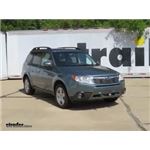

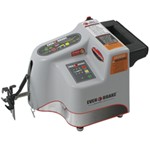
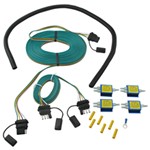
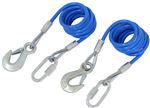
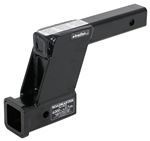















































































Paul L.
7/13/2018
Blue Ox tow bar and base plate work great.